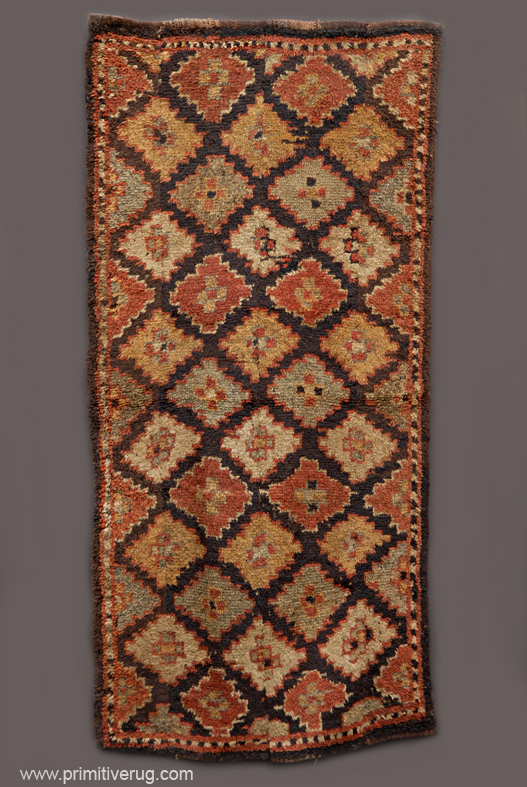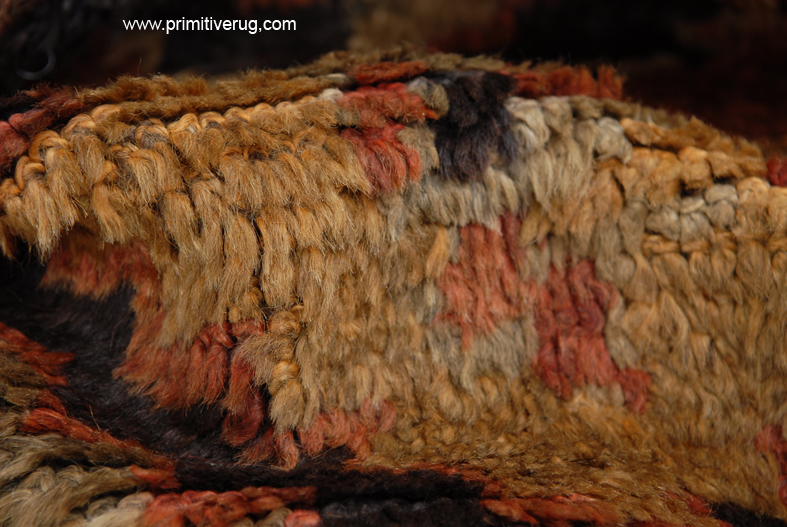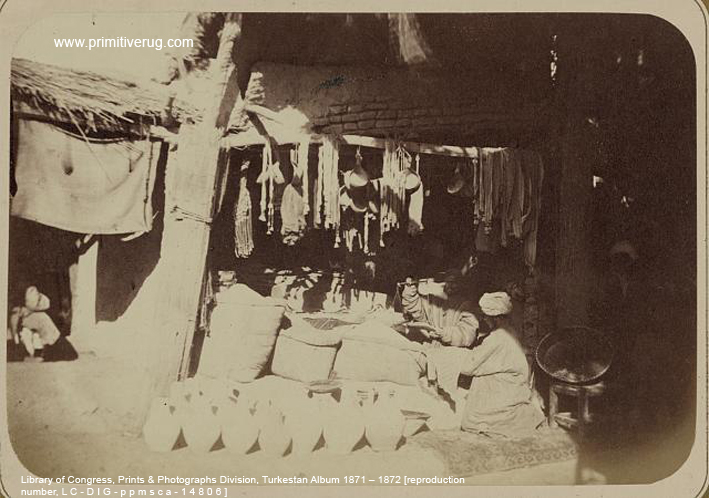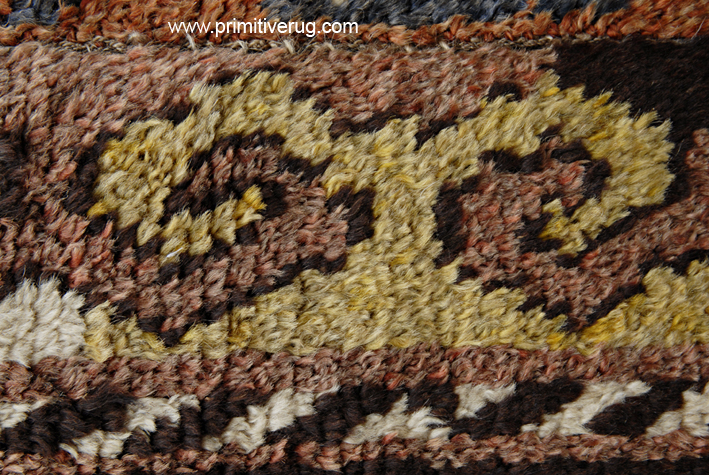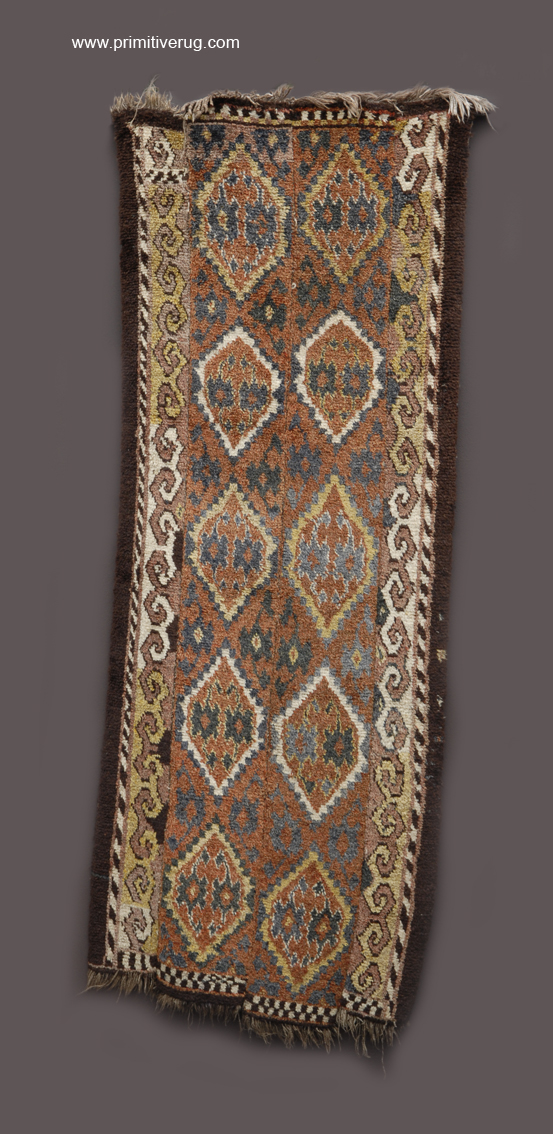
OXUS UZBEK JULKHIRS FRAGMENT Northern Afghanistan “Amu Darya.”
This Julkhirs is different, the knots are visible on the back and the rug is one piece not several. Usually Julkhirs are warp faced and the knots are either completely or partially hidden by the warps.

Julkhirs were woven in narrow long strips usually comprising of three to five strips stitched together to form one piece. Technical constraints dictated the width of the strips, keeping an open shed was difficult for the Bearskin weavers. 1
Some Julkihrs were woven as one – piece. Three Central Asian types exist and possibly more.
1. Nurata Turkmen Julkhirs from the Nurata basin in Uzbekistan, these are early and good luck finding one, Moshkova found that they were almost non existent when she visited the Nurata basin Turkmen Uzbeks in 1944 and 1946. 2 None that I have found fit Moshkova's description.
2. A second group which appear to be more recent and woven in Afghanistan by Kuchi Pashtun nomads – sometimes referred to as “Maldari”. Occasionally attributed to Uzbeks. They are large coarsely woven nomad rugs and will be the subject of an upcoming post.
3. “Amu Darya” Julkihrs from the north of Afghanistan bordering Tajikastan. The subject of this post.
Geroge O’Bannon first brought “Darya” Uzbek one – piece rugs to our attention in his mongraph Kazakh and Uzbek Rugs from Afghanistan, O’Bannon presented two examples - and called them Kazakh rugs. 3 In the following decades these “Kazakhs” became more popular. In From Desert and Oasis O’Bannon tentatively referenced them as “Darya” Uzbek and published a further example.

On his blog http://www.oturn.net/rugs/uzbek-julkhyr.html Detlev Fischer published an example – I’ve include an image here. The knotting and colours are the same.

In appearance all of these rugs are shaggy with long pile and woven in one piece. They also differ in that they are all approximately 183 cm x 122 cm (6’ x 4’) and sometimes even a little wider – 183cm x 137cm (6’ x 4.5’).
This fragment is much narrower and fits the proportions of the longer “pieced” Julkhirs yet it was woven in one long continuous piece. The warps are of brown goat hair and wefts of dark brown wool. The weave balance is more precise than in the other examples. Similarities with other “Darya Uzbek” examples are the Kuchkorak or latch hook polygons and colours.
O’bannon describes “Darya Uzbek” Julkhirs as having Kuchkoraks which are “wider horizontally than vertically”. 4 Our rug has vertically longer Kuchkorak’s and is only 1040 mm (40.94”) wide, a standard width for three and four piece Julkhirs. Unfortunately our fragment has been cut into small sections and only one third of the rug remains. The original full length Julkhirs would have been approximately 289 cm (113”) x 104 cm (40.9”) wide this ratio precisely fits measurements of what was standard length for many Julkihrs. I’ve used an image of the fragment to recreate a montage of how the rug may have looked in original form.
Description:Proportions are that of normal Julkhirs made in strips, not like other “Darya” Uzbek Julkhirs which were wider and probably shorter. Abrashed Madder red field plus yellow, blue, indigo, undyed white and brown.
Original size approximately 104 cm (3.4’ ) x 289 cm (9’6”)

Current Size 104 cm (3.4’ ) x 145 cm (57”)
Each Kuchkorak approximately 208mm (8.1”) vertical x 203mm (7.9”) horizontal
Wefts: 4 shots brown wool
Warps: Goat Hair
Pile: Wool, symmetrically knotted no warp depression
I gratefully acknowledge the enthusiasm shared by others for these shaggy nomad rugs, many thanks to Milton Cater for answering my many questions and helping keep me focused and motivated. "Darya Uzbek" fragment sourced for this project by Milton Cater http://www.orientalcarpets.com.au/
REFERENCES
1 Mallett. M Woven Structures A Guide To Oriental Rugs and Textile Analysis Christopher Publications Atlanta 2000. 58
2 Moshkova, V. G. Carpets of the People of Central Asia (George O’Bannon, Arizona Lithographers Tucson, Arizona, 1996) 112,120
3 O'Bannon G. Kazakh and Uzbek Rugs from Afghanistan. George W. O'Bannon. 1979 No 1 page 10 and No 2 page 11
4 O'Bannon G.From Desert and Oasis Arts of the People of Central Asia. Georgia Museum of Art University of Georgia. Exhibition Catalogue 1998 21 -22, 67


 Chest Vendor seated on Uzbek Julkhirs, Julkhyrs primitive rug Samarkand Zaravshan district between 1865 and 1872 from the Turkestan Album.
Chest Vendor seated on Uzbek Julkhirs, Julkhyrs primitive rug Samarkand Zaravshan district between 1865 and 1872 from the Turkestan Album.








